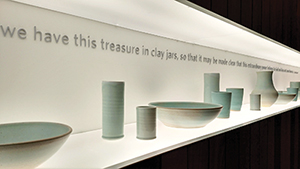BY KATHLEEN NELSON
Cups, bowls, jars, vases, a pitcher and basin: Each is crafted from clay and glazed in muted tones. The vessels are artfully arranged in a museum-worthy display and appealingly illuminated. The signature displays are prominently placed in 17 Mercy clinics or hospitals in Missouri, Arkansas, Kansas and Oklahoma.

Kistner
While beautiful, the Vessel Wall is much more than an artistic accent — it is intended as a visual representation of Mercy's mission and messaging. "We wanted the wall to be a greeting unique to Mercy, a message that welcomes and conveys who we are," says Elizabeth Kistner, Mercy's executive director of brand strategy and consumer research.
Many patients and visitors are drawn close enough to read the Scripture passage from Corinthians stenciled on the wall behind the pottery: "We have this treasure in clay jars, so that it may be made clear that this extraordinary power belongs to God and does not come from us."
"We want (viewers) to get closer and feel the texture of the vessels and read the line of Scripture," Kistner says. "If you watch, you can see that (viewers) are moved. I saw one woman break down in tears. That's how we know we're connecting with our patients and visitors."

Jones
"It's the surprise that draws people to it," Julie Jones, Mercy's vice president of mission and ministry, says of the displays. "Who expects pottery at a doctor's office? It seems like a museum (installation) until you realize it's not behind glass. Some people will even go up and touch the pieces."
The elegantly simple arrangement of clay vessels and Scripture passage can convey layers of symbolic meaning, Jones says, including:

A Vessel Wall at Mercy Virtual Care Center in Chesterfield, Mo., is part of an art initiative that reinforces Mercy's brand and mission.
Fragility: For millennia, clay vessels have been used to store things like oil, grain and wine — commodities that humans hold necessary or precious. Like clay, bodies are built to endure, but they are also fragile and must be cared for. Nothing is more precious than life and health.
Service: Each installation includes a basin. The Sisters of Mercy, who founded the Mercy system, take a vow of service. A basin of water is symbolic of pouring out compassion to those in their care. The basin also harkens to the Last Supper, when Jesus washed the feet of the apostles, then ordered them to go forth and do the same in service to others.
Diversity: The variety of shapes and vessel sizes symbolizes the array of talents displayed by Mercy's co-workers, as well as the purpose and worth inherent in every person. "We're each different, but together, we serve the same healing mission," Jones says.
Hospitality: Each wall also includes a cup as an homage to the final wish of the Venerable Catherine McAuley, founder of the Sisters of Mercy. Hospitality, as represented by the cup, is a cornerstone of the Sisters of Mercy and of the sponsored works they founded. Mother McAuley opened her Dublin home to women and children in need. Sr. Marilyn Sunderman, RSM, chair of theology at Saint Joseph's College in Maine, wrote about Mother McAuley's legendary hospitality in a blog post at sistersofmercy.org: As Mother McAuley lay on her deathbed, she comforted those sisters who visited her. She asked that immediately after her death everyone be served a cup of tea (considered a luxury item for women in service to the poor) to celebrate her "entrance into the eternal hospitality of God."
The healing touch: "You realize that someone's hands shaped each of these," Jones says of the vessels, "just like the healing touch of our doctors and nurses who touch each of our patients."
The first Vessel Wall was installed in 2013 at the Mercy clinic in O'Fallon, Mo., a suburb of St. Louis. Since then, they have been added to 16 Mercy facilities and will be added to five more.
For design coherence, all the Vessel Walls are horizontal shelves about 4 feet off the ground that are recessed into the wall. The displays in hospital lobbies contain about 20 pieces; the displays in clinics contain about a dozen.
The pottery is designed and crafted by nationally known potters Benjamin Maier, of Leland, Mich., and Dan Barnett of St. Louis.
Jones and Kistner have worked since 2010 on a team with other Mercy employees, as well as designers and architects "to develop a series of elements in in our facilities that would be welcoming and supportive for patients, visitors and staff, that would also tell our story," Kistner says.
The Vessel Wall is one of several elements the team proposed to reinforce Mercy's brand and mission in its facilities. Other elements include an illuminated glass tower. Rising from the main entrance of several facilities, it represents a lantern and symbolizes the system's mission to share its light with others, Jones says. Two crossbeams on the lantern form a cross.
Hospitality is measured in part by a guest's comfort. Mercy has designed seating areas in its clinics and larger waiting areas in some hospitals with the needs of patients and visitors in mind. One seat, for example, has an area to set a baby's pumpkin seat beside it. There is seating with adjacent floor space so a person in a wheelchair can sit next to a friend or family member.
"We wanted to convey healing in terms of color, light and space," Kistner says. "We want people to be calm here, to be open to a healing presence."
Copyright © 2018 by the Catholic Health Association
of the United States
For reprint permission, contact Betty Crosby or call (314) 253-3490.